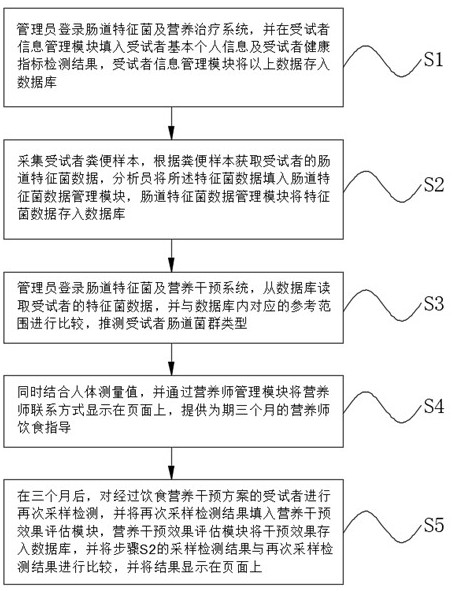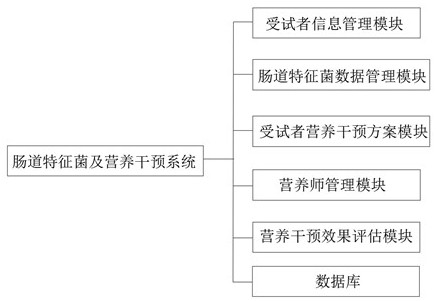Application of intestinal flora characteristic bacteria in dietary nutrition intervention of PCOS patient
A technology of intestinal flora and characteristic bacteria, applied in the field of microorganisms, can solve the problems of no nutritional intervention methods, improve diseases, etc., and achieve the precise and effective effect of personalized nutritional guidance
- Summary
- Abstract
- Description
- Claims
- Application Information
AI Technical Summary
Problems solved by technology
Method used
Image
Examples
Embodiment 1
[0037] This example uses a group of characteristic bacteria of the intestinal flora as markers to intervene in the diet and nutrition of patients with polycystic ovary syndrome.
[0038] Select a patient with polycystic ovary syndrome, and carry out dietary and nutritional intervention through the following methods, such as figure 1 shown, including the following steps:
[0039] S1. The administrator logs into the intestinal characteristic bacteria and nutritional intervention system, and fills in the basic personal information of the subject in the subject information management module. Fill in the subject information management module, and the subject information management module will store the above data into the database;
[0040] S2. Collect the subject's stool sample, obtain the subject's intestinal characteristic bacteria data according to the stool sample, the analyst fills the characteristic bacteria data into the intestinal characteristic bacteria data management m...
Embodiment 2
[0069] Another subject was selected, and the same method as in Example 1 was used to detect the content of intestinal characteristic bacteria by fluorescent quantitative PCR. The test results are shown in Table 6:
[0070] Table 6 Test results of characteristic bacteria
[0071]
[0072] The anthropometric values are shown in Table 7. After judging, the intestinal flora of the subject is Bacteroides type, and the subject was given the anti-inflammatory nutritional intervention plan-b-microecological preparation, as shown in Table 8 and Table 9 Shown:
[0073] Table 7 Anthropometric information
[0074]
[0075] Table 8 Example menu
[0076]
[0077] Table 9 Example dish replacement plan
[0078]
[0079] After three months, the subjects who had undergone the diet and nutrition intervention program were re-sampled and tested, and compared with the results before treatment. The health indicators of the subjects are shown in Table 10:
[0080] Table 10 Change ta...
Embodiment 3
[0089] A subject was selected, and the same method as in Example 1 was used to detect the content of intestinal characteristic bacteria by fluorescent quantitative PCR. The test results are shown in Table 11:
[0090] Table 11 Test results of characteristic bacteria
[0091]
[0092] Anthropometric measurements are shown in Table 12. It was judged that the intestinal flora of the subject was Prevotella type, and the subject was issued a health care nutrition intervention plan-p-microecological preparation, as shown in Table 13 and Table 14:
[0093] Table 12 Anthropometric information
[0094]
[0095] Table 13 Example menu
[0096]
[0097] Table 14 Example dish substitution plan
[0098]
[0099] After three months, the subjects who had undergone the diet and nutrition intervention program were re-sampled and tested, and compared with the results before treatment, the health indicators of the subjects were shown in Table 15:
[0100] Table 15 Change table of ...
PUM
 Login to View More
Login to View More Abstract
Description
Claims
Application Information
 Login to View More
Login to View More - R&D
- Intellectual Property
- Life Sciences
- Materials
- Tech Scout
- Unparalleled Data Quality
- Higher Quality Content
- 60% Fewer Hallucinations
Browse by: Latest US Patents, China's latest patents, Technical Efficacy Thesaurus, Application Domain, Technology Topic, Popular Technical Reports.
© 2025 PatSnap. All rights reserved.Legal|Privacy policy|Modern Slavery Act Transparency Statement|Sitemap|About US| Contact US: help@patsnap.com



